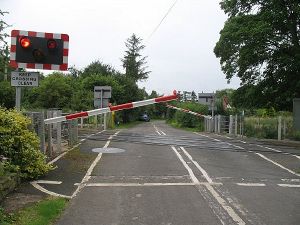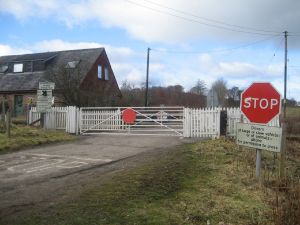Level Crossing
 | |
| A level crossing on the A474 | |
| Pictures related to Level Crossing View gallery (717) | |
A level crossing is an at-grade crossing between a road and a railway. As of May 2006 there were 7,674 crossings in the UK, though a large majority of them are for pedestrian use only. Of these crossings, 1,623 have some form of control (barriers or signals). Because of the dangers associated with level crossings, no new level crossings are to be constructed in the UK other than in exceptional circumstances.
Types of crossing
Manually controlled gates
The level crossing is controlled by a crossing operator, who manually opens and closes the gates or barriers as trains approach. Usually the barriers remain open when there is no train approaching, but on some quiet routes the operator will keep the gates closed and only open them when a user is needing to cross.
Manually controlled barriers
The crossing is once again controlled by a crossing operator, but there is no need for them to be on site. The operator can remotely operate the crossing through the use of CCTV to check if the crossing is clear. This type of crossing is generally found near stations and at busier locations. Usually wig-wag signals are provided to alert drivers to the closure of the crossing.
Automatic half barrier
This type of crossing is controlled automatically, initiated as a train approaches the crossing. Barriers block half of the road in each direction to prohibit oncoming vehicles from passing through. Because of the risks associated with trapping drivers on a level crossing, there are no automatic full barrier crossings in the UK. Emergency telephones are provided and the crossing is controlled by wig-wag signals. These crossings are either monitored remotely by signallers or locally by drivers of trains (see AOC, below).
The first automatic level crossing came into operation in May 1961 at Spath near Uttoxeter.
Automatic open crossing
There are no barriers or gates used at this type of crossing, just wig-wag signals to warn when a train is approaching. A St Andrews cross sign above the wig-wag signals indicates that it is an open crossing.
The crossing is (with one exception - Rosarie in Moray) monitored locally by trains drivers. A signal facing approaching trains flashes red normally and this changes to flashing white when the crossing is automatically activated to indicate to the train that the road traffic signals have activated.
Open crossing
These crossings are typically located where there is very little road and rail traffic. There are no barriers and no traffic signals – a user must give priority to any approaching train. A give way sign and markings are usually given and, as with automatic open crossings, a St Andrews cross sign indicates that the crossing is ungated. This type of crossing can only be used when there is adequate visibility of the railway line from the point where vehicles must stop, and train speeds through the crossing will also be low. Trains may be instructed to stop before the crossing and whistle before proceeding slowly across the road.
Other types
Other types of crossing may be restricted in who can use them. These generally involve the user opening and closing gates or barriers themselves. Sometimes miniature warning lights are installed to advise when its safe to cross. In other situations the user must telephone the signal box to get permission to cross the line.
Tram crossing
 | |
| A tram crossing on the A222 | |
| Pictures related to Tram Crossing View gallery (10) | |
It is common for a tram line to cross a road at street level, though the method of control is usually different, using conventional traffic lights, rather than wig-wags and barriers to stop traffic.
Locations
Level crossings
- List of Level Crossings in the North East
- List of Level Crossings in the North West
- List of Level Crossings in Yorkshire and the Humber
- List of Level Crossings in the East Midlands
- List of Level Crossings in the West Midlands
- List of Level Crossings in the East
- List of Level Crossings in the South East and London
- List of Level Crossings in the South West
- List of Level Crossings in Wales
- List of Level Crossings in Scotland
- List of Level Crossings in Ireland
- List of Level Crossings in Northern Ireland
Tram crossings











